Bhitargaon
Bhitargaon is a town in Kanpur district, Uttar Pradesh, India, known for its ancient Hindu temple, the largest Indian brick temple to survive from the time of the Gupta Empire. Despite being heavily restored, a number of original features remain.[1]

Bhitargaon Temple
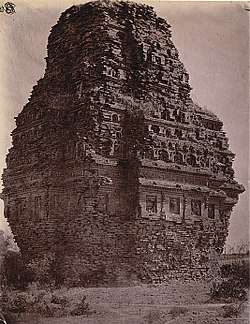
The Bhitargaon Temple is a terraced brick building fronted with a terracotta panel. Built in the 5th century during the Gupta period,[2][3][4][5][6][7][8][9] it is the oldest remaining brick/terracotta Hindu shrine with a roof and a high shikhara, though its upper chamber did sustain some damage in the 18th century.
The temple is built on a square plan with double-recessed corners and faces east. There is a tall pyramidal spire over the garbhagriha. The walls are decorated with terracotta panels depicting aquatic monsters, Shiva and Vishnu etc. When Alexander Cunningham first visited the site, the remains of the porch and of the ardhamandapa were still visible, which later collapsed.
Description of the architecture and layout of Bhitargaon temple
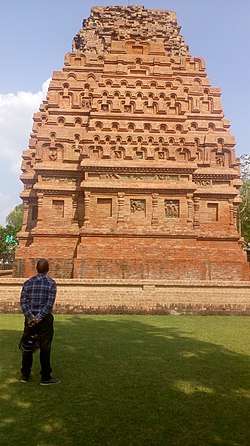
The construction material is bricks and terracotta. The brick size is 18" x 9 x 3" and the other salient features are following:
- The size of platform on which the temple is built is 36 feet x 47 feet.
- The santum is 15 feet x 15 feet internally.
- The santum is double story.
- The wall thickness is 8 feet.
- The total height from ground to top is 68.25 feet.
- There is no window.
- The terracotta sculpture depicts both secular and religious theme such as deities like Ganesha and Durga Mahisasurmardini. Myths and stories representing abduction of Sita and the penance of Nara-Narayana.
- Shikara is a stepped pyramid and got damaged by thunder in 1894.
- The first story of sanctum felled in 1850.
Behta Bujurg temple
There is another ancient temple in Behta Bujurg (or Behata Bujurg) village which is only 4.3 km far from bhitargaon, also protected by the Archaeological Survey of India.[10] The temple is dedicated to Lord Jagannath, and has a highly unusual curving shape, with buddhist stupa(Mound) like resemblance. However a close look reveals nagara style curvilinear shape. There are significant detached ancient sculptures: Lord Jagannath idol, a Surya (sun deity) sculpture and a Lord Vishnu sculpture carved on a large block of stone depicting lord vishnu resting on seshnaga. The temple is known locally as the "Rain Temple" as the ceiling is said to drip water several days before the rain arrive, which is of great interest to local farmers.[11]
Other historic brick temples
- Po Nagar and Po Klong Garai
- Mahabodhi Temple
- id:Candi Bima Dieng Candi Bima
- Sambor Prei Kuk
- Sirpur, Mahasamund Laksman temple
- Rajgir Maniyar Math, Vaibhar giri temples
- Bishnupur, Bankura
- Kherahat temple[12]
- Kalar, brick temple
Gallery
 Front view of the temple at Bhitargaon, 1875
Front view of the temple at Bhitargaon, 1875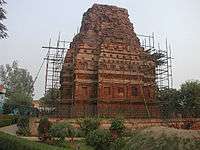 The oldest remaining Hindu shrine Brick Temple
The oldest remaining Hindu shrine Brick Temple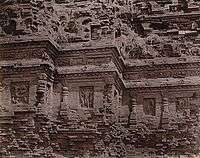 Close view of façade showing the detail of mouldings and sculpture niches, 1875
Close view of façade showing the detail of mouldings and sculpture niches, 1875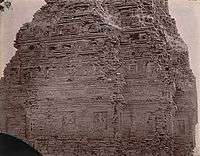 Close view of temple façade showing the detail of mouldings and sculpture niches, 1878
Close view of temple façade showing the detail of mouldings and sculpture niches, 1878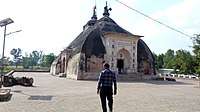 Behta Bujurg temple
Behta Bujurg temple
See also
- Hindu temple architecture#Historical ChronologyHindu temple architecture - Historical Chronology
- Gwalior#Teli k.C4.81 Mandir Teli Ka Mandir, Gwalior
References
| Wikimedia Commons has media related to Temple of Bhitargaon. |
| Wikimedia Commons has media related to Behta Bujurg temple. |
- Michell, George, The Penguin Guide to the Monuments of India, Volume 1: Buddhist, Jain, Hindu, p. 157, 1989, Penguin Books, ISBN 0140081445
- Schastok, Sara L., , The Śāmalājī Sculptures and 6th Century Art in Western India. BRILL, 1985.
- Jayewardene-Pillai, Shanti, Imperial Conversations: Indo-Britons and the Architecture of South India. Yoda Press, 2007.
- Begler, Joseph David, Rear view of the temple at Bhitargaon, Kanpur District. British Library, 2009.
- Brown, Percy, Indian Architecture (Buddhist and Hindu Periods). D B Taraporevala, Mumbai, 1959.
- Harle, J. C., Gupta Sculpture. Munshiram Manoharlal, New Delhi, 1974. ISBN 8121506417.
- Dalal, Roshen, The Religions of India: A Concise Guide to Nine Major Faiths. Penguin Books India, 2010.
- Kramrisch, Stella and Raymond Burnier, The Hindu Temple, Volume 1. Motilal Banarsidass Publ., 1976.
- de Laet, Sigfried J., History of Humanity: From the seventh to the sixteenth century. UNESCO, 1994.
- ASI notice
- News Express video (3:02, in Hindi)
- A Brick Temple of the Ninth Century, Michael D. Willis, Artibus Asiae, Vol. 52, No. 1/2 (1992), pp. 25-46, Artibus Asiae Publishers
External links
- Bhitargaon
- Heritage and Tourism, Kanpur City Development Plan
- Brick temples